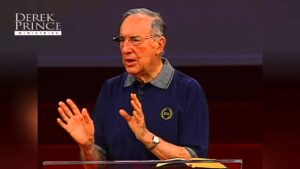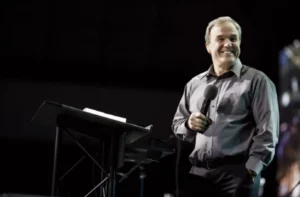
Messianic Judaism
Restoring the Church to the Original Blueprint
This picture taken at House of Agape in Kansas City, MO.
Messianic Judaism
A Return to the New Testament Church of the Book of Acts
What is a Messianic Jew?
By: Aaron Eby
All throughout history, there have been individuals of Jewish descent who have followed Jesus. Typically, this has meant leaving Judaism behind and embracing Christian theology and practice.
Towards the end of the 1800s, a new idea emerged among Jewish Christians. They realized that Jesus himself was Jewish, and in New Testament times, Christianity did not exist as a religion distinct from Judaism. So why should Jews who follow Jesus abandon their heritage to embrace something that was foreign even to him?
People began using the term "Messianic Jew" to describe a person of Jewish descent who chose to retain their Jewish religious identity and practice as a follower of Jesus. Instead of practicing a Jewish kind of Christianity, Messianic Jews saw themselves as practicing a special kind of Judaism that expressed devotion to Jesus. They referred to this kind of Judaism as “Messianic Judaism.”
When it first emerged over a century ago, it was not a popular idea. Many Jewish Christians actively opposed Messianic Judaism. They did not think it was appropriate for followers of the Messiah to participate in Jewish life. But some embraced Messianic Judaism, even though they were criticized for it. We think of these steadfast early Messianic Jews as our pioneers.
Today, people use the term “messianic” in many non-specific ways. But to be precise, not all Jewish followers of Jesus are Messianic Jews. A Jewish person who embraces the Christian faith is a Jewish Christian. In contrast, a Messianic Jew is a Jewish person who practices Messianic Judaism.
Jewish Christianity or Messianic Judaism?
The difference between Jewish Christianity and Messianic Judaism is simple: Jewish Christianity is Christianity that is Jewish. Messianic Judaism is Judaism that is Messianic.
To arrive at Jewish Christianity, you start with Christianity and add Jewish people and Jewish things. You add Jewish customs. You add Jewish songs. You add Jewish clothing and food.
To arrive at Messianic Judaism, you start with Judaism, and add Messianic things. You add the Messiah. You add the Messiah’s teaching. You add aspects of the future Messianic Kingdom, when Jesus will rule the earth. In the end, Messianic Judaism has some vaguely similar appearances to Jewish Christianity, but a radically different way of thinking.
Messianic Judaism (Hebrew: יהדות משיחית ; יַהֲדוּת מְשִׁיחִית, romanized: yahadút mešiḥít; Yahadut Meshikhit) is a label attached in recent years to a wide spectrum of modern religious movements. These range from Anglican - the term is owned by some members of Christ Church Jerusalem - to others that are less mainstream. Many members will add elements of Jewish practice to their Christian faith. As a result researchers may simplify and conclude that it only incorporates some elements of Christian doctrine (more specifically, that of Evangelical Christianity) with staunchly Jewish tradition and practice.
The movement emerged in the 1960s and 1970s from the Hebrew Christian movement and the Baptist organization Jews for Jesus founded in 1973 by Conservative Baptist minister Martin Rosen.
Messianic Jews believe that Yeshua is the Messiah, and that the Hebrew Bible and New Testament are the authoritative scriptures. Salvation in Messianic Judaism is achieved only through acceptance of Jesus as one's savior, and Jewish law does not contribute to salvation. Belief in Jesus as a messiah and divine is considered by Jews to be the defining distinction between Christianity and Judaism. Evangelical groups usually accept Messianic Judaism as a form of Christianity.
Adherents of Messianic Judaism believe that the movement is a sect of Judaism. In Hebrew they tend to refer to themselves as maaminim ("believers"), not converts, and yehudim ("Jews"), not notzrim ("Christians"). Jewish organizations reject this framing, and the Supreme Court of Israel has rejected this claim in cases related to the Law of Return, and instead consider Messianic Judaism to be a form of Christianity. There is discourse amongst scholars as to whether Messianic Judaism should be labeled a Christian or Jewish religious sect.
From 2003 to 2007, the movement grew from 150 Messianic houses of worship in the United States to as many as 438, with over 100 in Israel and more worldwide; congregations are often affiliated with larger Messianic organizations or alliances. As of 2012, population estimates for the United States were between 175,000 and 250,000 members, between 10,000 and 20,000 members for Israel, and an estimated total worldwide membership of 350,000.
History
Pre-19th century
Efforts by Jewish Christians to proselytize to Jews began in the 1st century, when Paul the Apostle preached at the synagogues in each city that he visited. However, by the 4th century CE, non-biblical accounts of missions to the Jews do not mention converted Jews playing any leading role in proselytization. Notable converts from Judaism who attempted to convert other Jews are more visible in historical sources beginning around the 13th century, when Jewish convert Pablo Christiani attempted to convert other Jews. This activity, however, typically lacked any independent Jewish-Christian congregations, and was often imposed through force by organized Christian churches.
19th and early 20th centuries
Main article: Hebrew Christian Movement
In the 19th century, some groups attempted to create congregations and societies of Jewish converts to Christianity, though most of these early organizations were short-lived. Early formal organizations run by converted Jews include: the Anglican London Society for promoting Christianity among the Jews of Joseph Frey (1809), which published the first Yiddish New Testament in 1821;[verification needed] the "Beni Abraham" association, established by Frey in 1813 with a group of 41 Jewish Christians who started meeting at Jews' Chapel, London for prayers Friday night and Sunday morning; and the London Hebrew Christian Alliance of Great Britain founded by Dr. Carl Schwartz in 1866.
The September 1813 meeting of Frey's "Beni Abraham" congregation at the rented "Jews' Chapel" in Spitalfields is sometimes pointed to as the birth of the semi-autonomous Hebrew Christian movement within Anglican and other established churches in Britain.[35] However, the minister of the chapel at Spitalfields evicted Frey and his congregation three years later, and Frey severed his connections with the Society. A new location was found and the Episcopal Jew's Chapel Abrahamic Society registered in 1835.
In Eastern Europe, Joseph Rabinowitz established a Hebrew Christian mission and congregation called "Israelites of the New Covenant" in Kishinev, Bessarabia, in 1884. Rabinowitz was supported from overseas by the Christian Hebraist Franz Delitzsch, translator of the first modern Hebrew translation of the New Testament. In 1865, Rabinowitz created a sample order of worship for Sabbath morning service based on a mixture of Jewish and Christian elements. Mark John Levy pressed the Church of England to allow members to embrace Jewish customs.
In the United States, a congregation of Jewish converts to Christianity was established in New York City in 1885. In the 1890s, immigrant Jewish converts to Christianity worshiped at the Methodist "Hope of Israel" mission on New York's Lower East Side while retaining some Jewish rites and customs. In 1895, the 9th edition of Hope of Israel's Our Hope magazine carried the subtitle "A Monthly Devoted to the Study of Prophecy and to Messianic Judaism", the first use of the term "Messianic Judaism". In 1894, Christian missionary Leopold Cohn, a convert from Judaism, founded the Brownsville Mission to the Jews in the Brownsville section of Brooklyn, New York as a Christian mission to Jews. After several changes in name, structure, and focus, the organization is now called Chosen People Ministries.
Missions to the Jews saw a period of growth between the 1920s and the 1960s. In the 1940s and 1950s, missionaries in Israel, including the Southern Baptists, adopted the term meshichyim (משיחיים, "messianics") to counter negative connotations of the word notsrim (נוצרים, "Christians"). The term was used to designate all Jews who had converted to Protestant Evangelical Christianity.
Modern-day Messianic Judaism movement, 1960s onwards
The Messianic Jewish movement emerged in the United States in the 1960s. Prior to this time, Jewish converts assimilated into gentile Christianity, as the church required abandoning their Jewishness and assuming gentile ways to receive baptism. Peter Hocken postulates that the Jesus movement which swept the nation in the 1960s triggered a change from Hebrew Christians to Messianic Jews, and was a distinctly charismatic movement. These Jews wanted to "stay Jewish while believing in Jesus". This impulse was amplified by the results of the Six-Day War and the restoration of Jerusalem to Jewish control.


